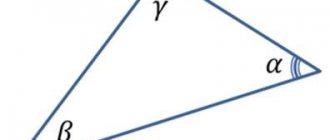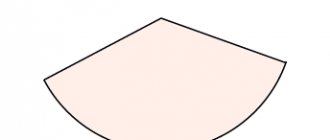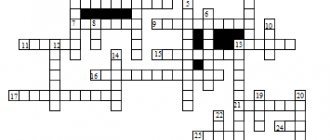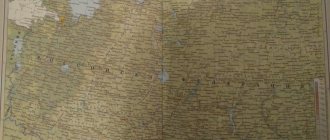Problems with fantasy – 18: Pythagorean theorem.
Do you think that the Pythagorean theorem is not at all difficult? Well, in general, yes. But interesting problems can still be encountered sometimes. We'll mostly be dealing with ratios and number comparisons here.
Problem 1. One of the legs of a right triangle is 10 more than the other and 10 less than the hypotenuse. Find the hypotenuse of this triangle.
Solution. Show
Let us write down the Pythagorean theorem for this triangle. To do this, we denote the legs and and the hypotenuse. Then
Where . Then the hypotenuse is 10 more - 50.
Answer: 50.
Problem 2. In triangle ABC, angle BAC is right, the lengths of sides AB and BC are equal to 1 and 3, respectively. Point K divides side AC in the ratio 7:1, counting from point A. Which is greater: length AC or length BK?
Solution. Show
Picture 1
To find which is the bisector in a triangle, you need to know the length of the leg. Let's find it:
Now for the triangle we will compose the Pythagorean theorem
It remains to compare the numbers and 3. Let's imagine the latter as
Answer: longer.
Problem 3. In rectangle ABCD, the lengths of segments AB and BD are equal to 2 and , respectively. Point M divides segment CD in the ratio 1:2, counting from point C, K is the middle of AD. Which is longer: length BK or length AM?
Solution. Show
Figure 2
Let's define first. We'll find it for this.
Now we move on to the triangle, where is the hypotenuse.
Let's find now:
It remains to compare the fractions and . When reduced to a common denominator we get
Thus, the length is greater than the length. This is the answer.
Problem 4. In triangle ABC, angle BAC is right, the lengths of sides AB and BC are 5 and 6, respectively. Point K divides side AC in the ratio 3:1, counting from point A, AH is the altitude of triangle ABC. What is greater: 2 or the ratio of the length BK to the length AH?
Solution. Show
Figure 3
To find the height of a triangle, we determine its double area, since
Let's determine by the Pythagorean theorem:
Now let's find to find:
Then
Attitude
Let us now compare and .
Thus, .
Problem 5. In an isosceles triangle ABC, the length of the base AC is 2, the length of the side is 8. Point K divides the height BD of the triangle in the ratio 2:3, counting from point B. Which is greater: the length CK or the length AC?
Solution. Show
Figure 4
Height length:
Section length:
Using the Pythagorean theorem we determine:
Thus, .
Problem 6. Find the radii of the inscribed and excircles of a triangle with sides 3, 4, 5.
Solution. Show
The triangle obeys the Pythagorean theorem; it is rectangular. Its hypotenuse. Let the legs , .
First the inscribed circle.
Figure 5
Let be the tangent points of the circle. Then, by the theorem about tangent segments drawn from one point, . But the lengths of these segments are equal to the radius. Then
Where
Now the excircles: let's look at the green one first.
Figure 6
By the theorem about tangent segments drawn from one point, , .
But . Then (the perimeter of the triangle). But, again, by the property of tangents. Then .
Since then
Now let's look at the purple circle.
, .
But . Then (the perimeter of the triangle). But, again, by the property of tangents. Then .
Since then
Finally, the last one, the biggest one.
Answer: , , , .
Problem 7. From one point, a perpendicular and two oblique lines are drawn to a given line. Find the length of the perpendicular if the obliques are 41 and 50, and their projections onto a given line are in the ratio 3:10.
Solution. Show
Figure 7
According to the Pythagorean theorem
Then
Where, therefore, .
Answer: 40.
Problem 8. In a right triangle, the medians drawn from the vertices of the acute angles are equal to and . Find the hypotenuse of the triangle.
Solution. Show
Figure 8
Let's compose the Pythagorean theorem for triangles and. Let it be then
If , then
We multiply the first equation by 4 to equalize the coefficients:
Subtract the second equation from it:
Therefore, the legs of the triangle are 6 and 8, the hypotenuse is therefore 10.
Answer: 10.
Problem 9. In a right triangle, the tangency point of the inscribed circle divides the hypotenuse into segments equal to 5 and 12. Find the legs of the triangle.
Solution. Show
Figure 9
By the property of tangents drawn to a circle from one point, we have: , , . Then
Using Vieta's theorem we obtain the roots: 3 and (-20). By condition, a positive root is satisfactory. The legs are then 8 and 15.
Answer: 8 and 15.
Geometry lesson summary “Pythagorean Theorem”, 8th grade
Lesson summary in mathematics, grade 8, “Pythagorean Theorem.”
Mathematics teacher Tatyana Evgenievna Zaitseva.
Place of work MBOU Secondary School No. 13, Novosibirsk. Abstract: development of a geometry lesson in 8th grade on the topic “Pythagorean Theorem.” Reinforcement of educational material, application of the Pythagorean theorem in solving practical problems.
Lesson topic “Pythagorean Theorem”
Purpose: 1. To consolidate the ability to apply the Pythagorean theorem and the inverse theorem to the Pythagorean theorem when solving applied problems. 2. Develop independence and cognitive interest in studying geometry, logical thinking and self-control skills. 3. Foster a culture of mathematical speech and respect for the opinions of others. Objectives: 1) Help students develop skills in working with additional information, the ability to generalize and independently draw conclusions. 2) Continue to develop analytical skills, the ability to construct proofs when studying the theorem. 3) Help students find the meaning of the applicability of the theorem for humanity in everyday life, construction in different eras of human existence. 4) To cultivate aesthetic taste in students through the perception of paintings and beauty; 5) Help in developing students’ cognitive interest in studying geometry; 5) Continue to develop the skills to present the results of your work. Type of lesson: lesson on consolidating acquired knowledge Forms of work: frontal, group, individual, independent Equipment: • personal computer • multimedia projector • screen • author’s presentation prepared using Microsoft Power Point • CD – disk, multimedia course “PLANIMETRY”, series “ Open mathematics" PHYSICON (www.physicon.ru), a complete interactive mathematics course for educational institutions in Russia, VERSION 2.5 • cards with tasks Lesson structure 1. Organizational point 2. Updating students’ existing knowledge on the topic (formulation and proof of the Pythagorean theorem, solving problems according to ready-made drawings) 3. Messages from students (historical background, consideration of classical proofs of the Pythagorean theorem) 4. Solution of practical and ancient problems 5. Test work with self-control 6. Summary of the lesson. Reflection 7. Homework PROGRESS OF THE LESSON: 1. Organizational moment of the lesson:
greeting, checking readiness for the lesson (workbooks, textbooks, writing materials).
Lesson topic slide 1, lesson goal slide 2, lesson plan slide 3. (1-2 minutes)
2.
Updating the knowledge acquired by students in the previous lesson (5 minutes)
: • Formulation of the Pythagorean theorem;
slide 4 • Formulation of the theorem converse to the Pythagorean theorem slide 5 The proof of the Pythagorean theorem can be carried out using the multimedia disk “PLANIMETRY”, version 2.5, series “OPEN MATHEMATICS” Physikon. (Models. 5.2. Proof of the Pythagorean theorem)
This model illustrates the geometric proof of the Pythagorean theorem. Using the mouse, you can select an arbitrary right triangle. In Demonstration mode, the model automatically shows a geometric proof of the Pythagorean theorem. In the “Prove it yourself” mode, you can make the independent constructions necessary for the proof by changing the positions of the triangles in the square. In order to update their knowledge, students are offered tasks based on ready-made drawings. 2.1. Slide 6. Find the unknown side of the triangle.
2.2. Slide 7. Solve the problem (finding the perimeter of a rhombus using the Pythagorean theorem)
2.3. Slide 8. Problem on applying the theorem inverse to the Pythagorean theorem
3. Student reports (5-7 minutes) . 3.1. An excursion into history. Getting to know the life and achievements of the great scientist. The history of the discovery of the Pythagorean theorem. 3.2. Students are asked to compare the proposed proof with the proof discussed in the previous lesson, to identify similarities and differences. 4. Consolidation of the Pythagorean theorem when solving practical and ancient problems (10-15 minutes). Work in pairs followed by testing. 4.1. Task No. 1 (slide 9) “Old Russian task.” The conditions of the problem are understood orally, and students write down the drawing and solution in their notebooks. (Answer: 44 feet)
.
4.2.
Task No. 2 (slide 10) “Polar by the river” - for oral solution. (Answer: 8 feet).
4.3. Task No. 3 (slide 11). Finding the length of the main alley of the Central Park of the city of Novosibirsk.
The conditions of the problem are analyzed orally, students write down the drawing and solution in notebooks, 1 student works at the board. (Answer: 412 m).
4.4.
Task No. 4 ( multimedia CD, PLANIMETRY) Contents. CHAPTER 5. Solving triangles.5.1. Right triangle. Tasks. Task No. 6.
5. Independent work with self-control (15 minutes). Students are offered a TEST, cards (see appendix) with tasks for 2 options. Students write down their names and answers on cards, and a short solution in their notebooks.
6. Lesson summary. Reflection (3-5 minutes). (slide 12) At the end of the lesson, it is summed up, a discussion of what was learned and how they worked - i.e. everyone evaluates their contribution to achieving the goals set at the beginning of the lesson, their activity, the effectiveness of the class, the fascination and usefulness of the chosen forms of work. The guys speak in one sentence, choosing the beginning of a phrase from the reflective screen on the board: today I learned... it was interesting... it was difficult... I completed tasks... I realized that... now I can... I felt that... I acquired... I learned... from me it worked out... I could... I'll try... I was surprised... gave me a lesson for life... I wanted... 7. Homework. 1. The pediment of the Bolshoi Theater in Moscow has the shape of an isosceles triangle with sides of 21.5 m and a base of 42 m (dimensions are approximate). Calculate the area of the gable. 2. Find another proof of the Pythagorean theorem (optional).
We recommend watching:
Crossword puzzle on geometry with answers for grade 8. Synopsis of an algebra lesson on the topic “Quadratic Equations” using an interactive teaching aid. Extracurricular event in mathematics, grades 7-9. Multi-level system of educational and training tasks on the topic: Fractional-rational equations, grade 8.
Similar articles:
Mathematics elective program, grades 8-9
Mathematics Olympiad in 8th grade with solution
Algebra lesson notes for 8th grade. Solving Quadratic Equations
Open algebra lesson in 8th grade “Solving quadratic equations using a formula”
Algebra lesson in 8th grade. Lesson topic: “Solving problems using rational equations”







